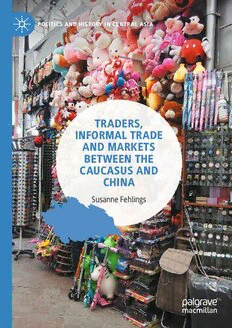
Traders, Informal Trade and Markets between the Caucasus and China PDF
Preview Traders, Informal Trade and Markets between the Caucasus and China
POLITICS AND HISTORY IN CENTRAL ASIA TRADERS, INFORMAL TRADE AND MARKETS BETWEEN THE CAUCASUS AND CHINA Susanne Fehlings Politics and History in Central Asia Series Editor Timur Dadabaev, University of Tsukuba, Tsukuba, Japan Inthepastfewdecades,CentralAsiahasdrawntheattentionofacademic and business communities as well as policy professionals because of its geostrategic importance (being located between Russia and China and in close proximity to Afghanistan, Pakistan, Iran, Turkey, and India), its international stability, and its rich energy resources. The region also faces challenges, such as post-conflict peacebuilding, impacts of the Afghan conflict,anumberofrecentinter-ethnicconflicts,andpost-Socialistdevel- opment paradigms. Approaching the problems and issues related to this region requires a multi-disciplinary perspective that takes into account political science, international relations, political economy, anthropology, geography, and security studies. The Politics and History in Central Asia series serves as a platform for emerging scholarship on this understudied region. Susanne Fehlings Traders, Informal Trade and Markets between the Caucasus and China Susanne Fehlings Frobenius-Institut Frankfurt am Main, Germany Politics and History in Central Asia ISBN 978-981-19-5204-3 ISBN 978-981-19-5205-0 (eBook) https://doi.org/10.1007/978-981-19-5205-0 © The Editor(s) (if applicable) and The Author(s), under exclusive license to Springer Nature Singapore Pte Ltd. 2022 This work is subject to copyright. All rights are solely and exclusively licensed by the Publisher, whether the whole or part of the material is concerned, specifically the rights of translation, reprinting, reuse of illustrations, recitation, broadcasting, reproduction on microfilms or in any other physical way, and transmission or information storage and retrieval,electronicadaptation,computersoftware,orbysimilarordissimilarmethodology now known or hereafter developed. The use of general descriptive names, registered names, trademarks, service marks, etc. in this publication does not imply, even in the absence of a specific statement, that such namesareexemptfromtherelevantprotectivelawsandregulationsandthereforefreefor general use. Thepublisher,theauthors,andtheeditorsaresafetoassumethattheadviceandinforma- tion in this book are believed to be true and accurate at the date of publication. Neither the publisher nor the authors or the editors give a warranty, expressed or implied, with respecttothematerialcontainedhereinorforanyerrorsoromissionsthatmayhavebeen made.Thepublisherremainsneutralwithregardtojurisdictionalclaimsinpublishedmaps and institutional affiliations. Cover credit: © Susanne Fehlings This Palgrave Macmillan imprint is published by the registered company Springer Nature Singapore Pte Ltd. Theregisteredcompanyaddressis:152BeachRoad,#21-01/04GatewayEast,Singapore 189721, Singapore Praise for Traders,InformalTrade andMarketsbetweentheCaucasus andChina “Dr. Fehlings’ book is an important step towards a historical economic anthropology of everyday economic action, because she succeeds excel- lently in making this everyday action transparent in its diversity and its historical plasticity.” —Werner Plumpe, Professor of Economic History, Goethe University, Germany “Why and how do Georgian and Chinese traders travel across Eurasia withoutanyformalinstitutionalsupportandwhatconsequencesarethere of such ‘globalization from below’ for economy, markets, sociality and materiality? Susanne Fehlings’ ethnography skilfully explores the structural condi- tions, background and everyday lives of such traders and businessmen, scrutinizes their activities, narratives and logics of action and offers a rich anthropological discussionembedded in historical, legal and political contexts. ” —Lale Yalçın-Heckmann, Docent for Social Anthropology, University of Pardubice, Czech Republic v Contents 1 Introduction: Markets, Trade, and the Study of the Post-Soviet Economy 1 Marketplaces and Long-Distance Trade in Anthropology 9 Post-Soviet Markets and Their Background 13 Markets and Trade in Post-Soviet Economies 16 Fieldwork and Data Collection 18 Structure and Argument of the Book 22 References 27 2 From Chelnoki (Shuttle Traders) to Biznesmeny 37 Chelnoki 38 Biznesmeny and the Bazaar 44 Biznes in “Russian Beijing” 50 The Social Life of Biznes 70 Biznes Culture and Its Rules 82 Conclusion 88 References 90 3 Caucasian Biznes, Local Trade, and Entrepreneurship 97 Business Parameters 101 Location and Types of Commerce 102 Personal Background 116 Social Networks 130 Mobility 142 vii viii CONTENTS Goods 146 Quantity, Transport, and Frequency 150 Putting the Parts Together 151 Ideology: Ideas, Beliefs, and Value Systems 158 Entrepreneurs in Local Ecosystems 161 Conclusion 174 References 175 4 Dealing with Institutional Frameworks 187 Loans 191 Lending by Private Credit Agencies (the Example of BIG) 192 Microfinance and the Banking Sector 199 Traders as Clients 205 Bureaucracy 208 Customs Clearance 210 Digitalization 218 Legislation 222 From Shevardnadze to the Rose Revolution 223 Law Versus Alternatives 225 Law’s Impact on Trade 230 Assessments of the State 232 Conclusion 239 References 241 5 Chinelebi: Chinese Entrepreneurs in the Caucasus 249 The Chinese Market at Lilo Bazroba 252 Hualing City and Sea Plaza 256 The Chinese Presence in Georgia 263 Globalization with a Chinese Face 266 The Georgia-China Partnership 272 Chinese-Georgian Encounters on the Ground 279 Hualing Group as Employer 281 Hualing’s Encounters with Georgian Formal Institutions 288 Analysis of Chinese Activities in Georgia 292 “Cultural Brokers” and “Guanxi” 295 “Encompassing Accumulation” 300 CONTENTS ix Conclusion 301 References 302 Epilogue 309 References 315 Index 345 Note on Language For the different languages I used different systems for transliteration. (cid:129) For Cyrillic into Latin characters the ISO 9 (1995) system, except forestablishedwritingsofnames(e.g.,CherkisovskyRynok)andthe term “chelnoki”. (cid:129) ForGeorgianintoLatincharacters,withthehelpofZakhariaPourt- skhvanidze, the ISO 9984 system, except for established writings of names and places. (cid:129) For Armenian into Latin characters the ISO 9985 system. (cid:129) The Chinese characters are copied from the characters used in literature. xi
